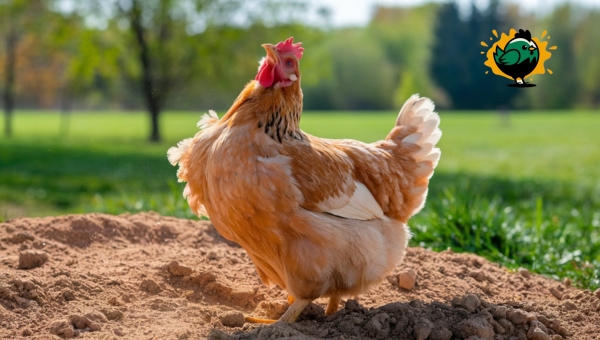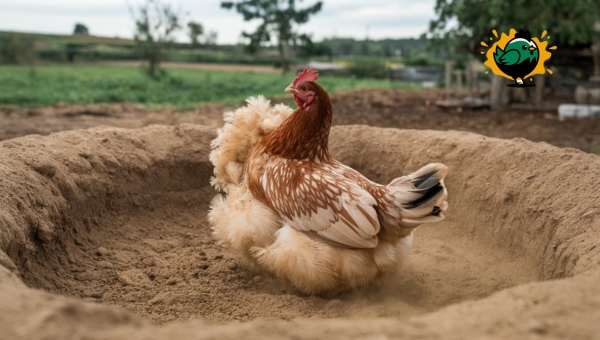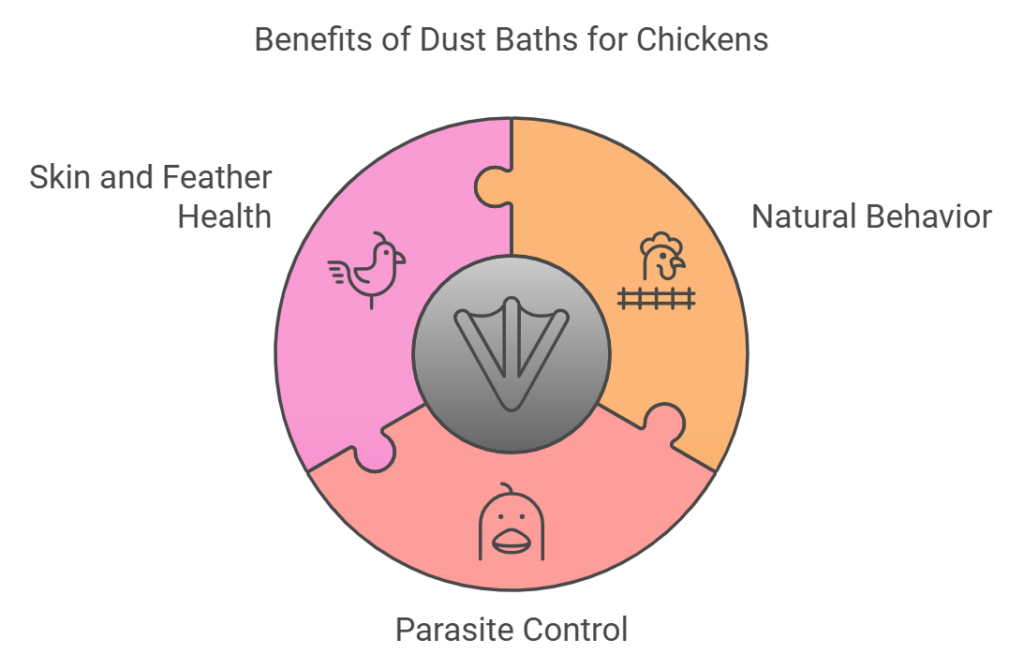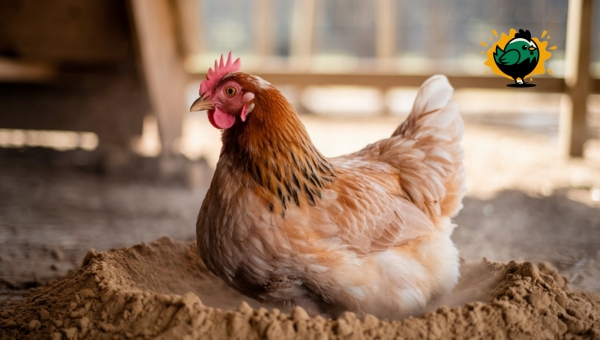Chicken Dust Bath – Essential Guide for Happy Hens

A sunny afternoon as you watch your chickens, feathers fluffed and content, indulging in a chicken dust bath. This delightful ritual is more than just a playful romp in the dirt—it’s an essential part of their well-being. Chickens instinctively seek dust baths to maintain their hygiene, ward off pesky parasites, and soothe their skin.
As a chicken owner, understanding this behavior can transform your backyard into a haven of health and happiness for your flock. Dive into the fascinating world of chicken dust baths and discover how to recreate this natural spa experience for your feathered friends.
Why do chickens have dust baths?
Chickens engage in dust baths as a fundamental behavior crucial for their well-being. This activity allows them to cleanse their feathers, effectively removing excess oil and moisture.
By rolling in loose dirt or sand, they also repel parasites like mites and lice, which can cause skin irritation and impact egg production.

Dust bathing serves as a social activity, promoting interaction and exercise among flock members. It’s akin to a spa day for chickens, offering relaxation and hygiene maintenance. This natural behavior ensures they stay healthy, comfortable, and free from pests, reflecting their instinctive grooming needs.
Benefits of Dust Baths for Chickens
Dust bathing is more than just a quirky habit for chickens; it plays a vital role in their overall health. This natural activity is essential for chickens, contributing to their well-being in multiple ways. Let’s dive into the fascinating benefits of dust baths, covering instinctive behaviors, parasite management, and skin health.

Natural Behavior
Dust bathing is an instinctive and satisfying activity for chickens. This behavior allows them to fulfill their natural grooming needs, ensuring they stay clean and comfortable.
By rolling and flapping in the dust, chickens engage in a social activity that promotes interaction among flock members. It’s a simple yet effective way for them to exercise and enjoy themselves, reminiscent of a spa day.
Parasite Control
A dust bath is an effective tool for managing parasites, contributing to the health of your flock. Chickens use the fine particles of dust to dislodge pests such as mites and lice.
This natural method reduces the risk of skin irritation and disease, keeping chickens healthy without the need for chemical treatments. By incorporating regular dust baths, you can help ensure a pest-free environment for your chickens.
Skin and Feather Health
Maintaining healthy skin and feathers is crucial for chickens, and dust baths play a key role in this process. The dust helps in cleaning their feathers, removing excess oils and dirt.
This natural preening behavior not only keeps their feathers in top condition but also promotes healthier skin. Regular dust bathing supports the natural grooming habits of chickens, ensuring they remain vibrant and resilient.
Also Read: Calico Princess Chicken-The Best Guide for Backyard Farmers
How to Create the Perfect Chicken Dust Bath?
Creating the ideal chicken dust bath is essential for maintaining the health and happiness of your flock. By providing the right materials and setting up in the perfect location, you can ensure your chickens have a space to engage in this natural behavior.
Let’s explore the key ingredients, location tips, and a DIY setup guide to help you craft the ultimate dust bath for your feathered friends.

Key Ingredients for an Effective Dust Bath
To create a chicken dust bath that effectively serves its purpose, the right mix of materials is important. Here are the essential components:
- Sand: Offers a gritty texture that helps clean feathers.
- Fine Dirt: Readily available and effective for dust bathing.
- Diatomaceous Earth: Assists in pest control; use sparingly.
Location Matters: Where to Set Up a Dust Bath
Choosing the right spot for your dust bath can enhance its usefulness. Consider these factors:
- Sun Exposure: Select a sunny area to keep the dust bath warm and inviting.
- Drainage: Ensure the location has good drainage to prevent a muddy mess.
- Accessibility: Place the bath in an area where chickens can easily reach it.
DIY Chicken Dust Bath Setup
Creating a DIY chicken dust bath is straightforward with these steps:
- Choose a Container: Opt for a shallow box, tub, or sandbox to hold the materials.
- Mix Ingredients: Combine sand, fine dirt, and a small amount of diatomaceous earth.
- Maintenance Tips: Regularly clean out any droppings and top up the materials as needed.
Best Materials for a Chicken Dust Bath
Creating an effective chicken dust bath involves selecting the right materials to ensure your flock stays healthy and happy. The materials you choose can significantly influence how well the dust bath functions. Let’s explore the top options for crafting a dust bath that your chickens will love.
Sand and Fine Dirt
Sand and fine dirt are the core materials for any effective chicken dust bath. They provide the right texture that chickens need to clean their feathers and skin. Sand is particularly beneficial because it aids in removing parasites and excess oil from feathers.
Fine dirt, on the other hand, is readily available and supports the natural dust bathing behavior that chickens instinctively perform. Together, they create an ideal environment for chickens to maintain their hygiene.
Diatomaceous Earth: Is It Safe?
Diatomaceous earth can be a valuable addition to a chicken dust bath, but it’s important to weigh its pros and cons:
- Pros: It is known for its pest control benefits, helping to keep mites and lice at bay, which can be beneficial for maintaining chicken health.
- Cons: It can be harmful if inhaled, so it’s crucial to use it cautiously and in small amounts.
- Safety Precautions: Always ensure it is food-grade and mix it well with other materials to minimize airborne particles.
Ash and Charcoal: Natural Additives for Extra Cleanliness
Adding wood ash or charcoal to your chicken dust bath can enhance its effectiveness:
- Wood Ash: This can add beneficial minerals to the bath and helps in deodorizing the area, making it more pleasant for your chickens.
- Charcoal: Known for its odor-absorbing properties, charcoal can help maintain a fresh environment and offers additional pest control benefits.
By carefully selecting and combining these materials, you can create a dust bath that supports the health and well-being of your chickens.
Also Read: Chicken Toys [Engage Your Chickens with These Fun Tools]
Common Mistakes to Avoid When Creating a Chicken Dust Bath
Creating a chicken dust bath can be simple, yet there are several mistakes to watch out for:
- Using Wet Materials: This can lead to a soggy mess, making it unappealing for chickens.
- Wrong Location: Placing the bath in a shaded or poorly drained area can result in mud rather than dust.
- Inadequate Materials: Avoid using substances that may contain chemicals or irritants.
- Neglecting Maintenance: Regularly clean and refresh the bath to keep it effective.
- Ignoring Accessibility: Ensure that chickens can easily reach the bath to enjoy its benefits.
These considerations help maintain an inviting and functional dust bath for your flock.
FAQs
How often should chickens use a dust bath?
Chickens should have access to a dust bath regularly, ideally every day. This frequent use helps them maintain optimal hygiene and control parasites effectively.
Can chickens use a dust bath in winter?
Yes, chickens can use dust baths in winter. It’s important to provide a sheltered area with dry materials so they can continue dust bathing even in colder conditions.
Is diatomaceous earth safe for chickens?
Diatomaceous earth can be safe if used carefully. Ensure it’s food-grade and avoid inhalation by both chickens and handlers to prevent respiratory issues.
Conclusion
Creating a chicken dust bath is essential for the well-being of your flock. By providing a space for dust bathing, you help chickens maintain their natural grooming habits, control parasites, and ensure healthy skin and feathers.
The right materials, such as sand and fine dirt, play a crucial role in making the bath effective. Avoid common mistakes like poor location choice or neglecting maintenance to keep the bath inviting and functional. Understanding these elements will significantly benefit your chickens’ health and happiness.
Explore more insightful articles on our site to enhance your knowledge and improve your poultry care practices. Dive into our blog for more engaging content!
